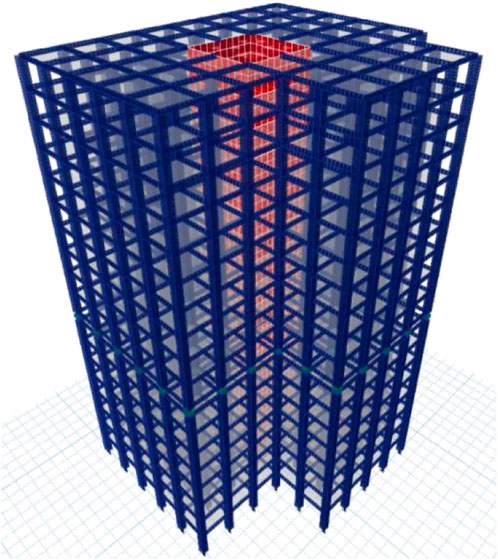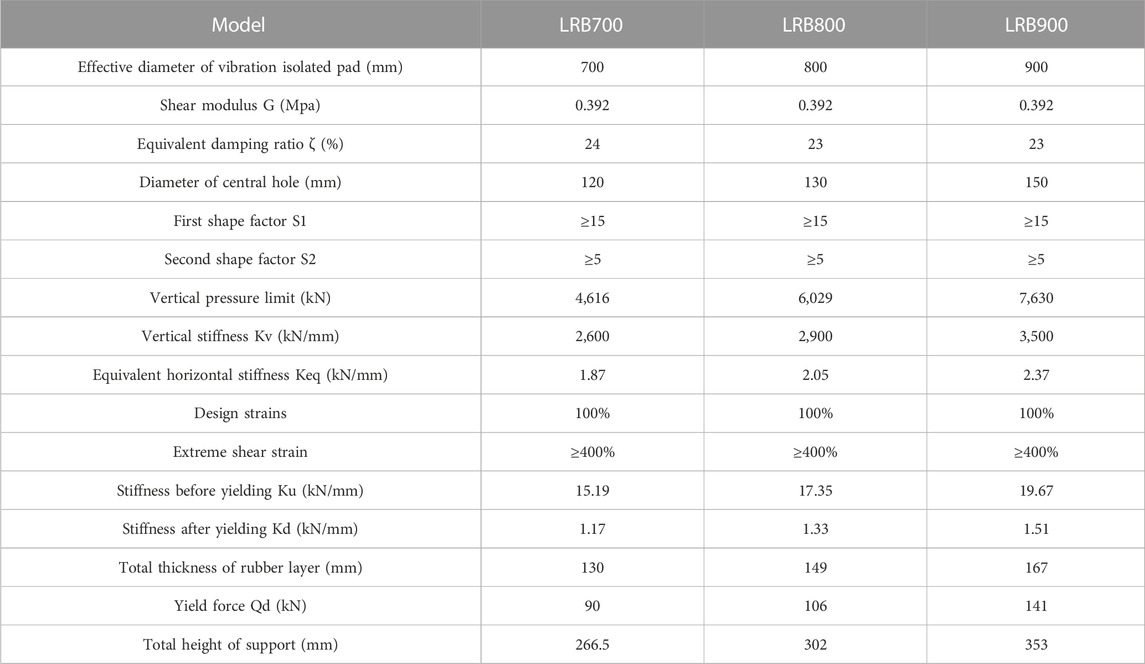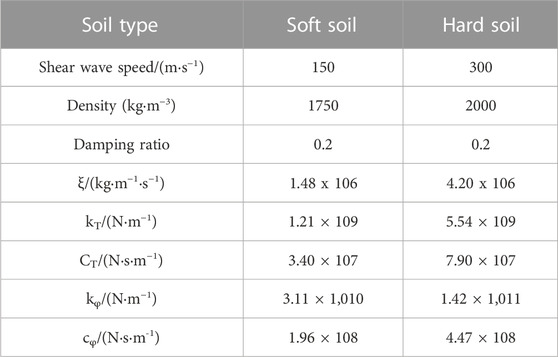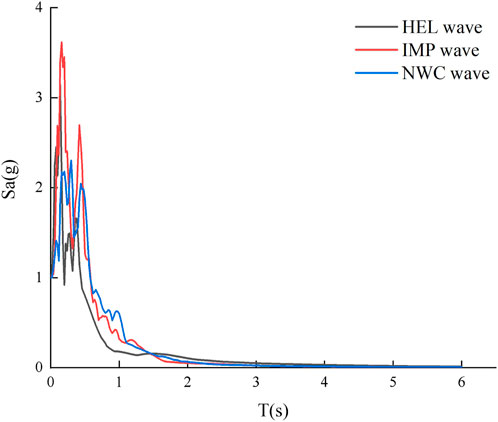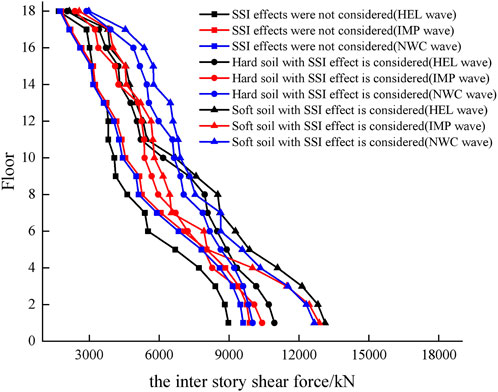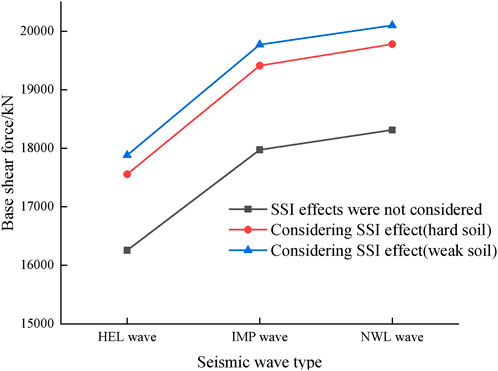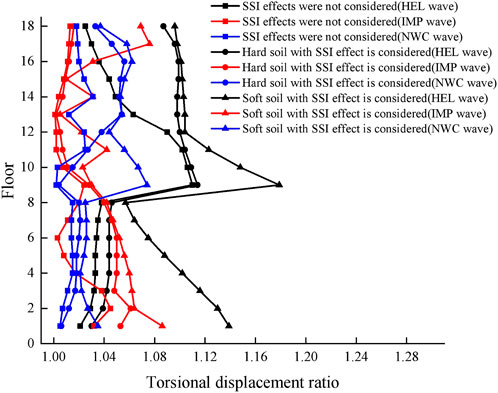- 1College of Civil Engineering, Southwest Forestry University, Kunming, Yunnan, China
- 2Discipline Inspection and Supervision Office, Hebei Open University, Shijiazhuang, China
- 3School of Traffic and Transportation, Shijiazhuang Tiedao University, Shijiazhuang, China
- 4School of Civil Engineering, Southwest Jiaotong University, Chengdu, Sichuan, China
The rock composition of karst area is mainly limestone, which is easy to be eroded and dissolved by water, forming a complex and fragile tectonics. Under the action of earthquake, the instability of stratum is aggravated. The mid story isolation structure is a new type of isolation structure developed from the basic isolation structure, and irregular mid story isolation buildings are highly susceptible to adverse seismic conditions. Previous studies have mostly adopted the assumption of rigid foundations, neglecting the influence of soil on irregular structures. In order to study the seismic response of isolated structures in irregular planes in karst earthquake prone areas considering soil structure interaction, a finite element model of isolated structures in irregular planes considering soil component interaction was established, and the seismic response of the structure under rigid foundation was calculated. Soft and hard soil foundations were studied, and compared with structures without considering SSI effect. Research shows that when considering the SSI effect, the seismic response of the structure increases and the damage to the structure intensifies; When considering SSI, the seismic response of soft soil is greater than that of hard soil, and the softer the soil, the more obvious it becomes; After considering the SSI effect, the torsional effect caused by the irregularity of the plane increases; The design of building structures should fully consider the adverse effects of soil layers on the seismic response of structures under plane interlayer seismic irregularities. In the design of building structures, it is necessary to fully consider the adverse effects of irregular planes on the seismic response of the structure. This consideration is particularly important in the design of soft soil high-rise buildings in karst earthquake areas to prevent unsafe designs and consider the SSI effect in actual seismic resistance.
1 Introduction
The rock composition of karst area is mainly limestone, which is easy to be eroded and dissolved by water, forming a complex and fragile tectonics. Under the action of earthquake, the instability of stratum is aggravated. The mid-story isolated structure is a new type of seismic isolated structure developed on the basis of the base isolated structure, while the mid-story isolated structure with an irregular plan is extremely prone to adverse seismic conditions. Previous studies have mostly adopted the assumption of rigid foundations and ignored the impact of soil on the structure with an irregular plan. The research on the structure with an irregular plan considering soil-structure interaction (SSI) effect is mainly focused on seismic and base isolated structures, and there is less research on the mid-story isolated structure with an irregular plan considering SSI effect of SSI.
Losanno et al. (2021) conducted a meticulous study of the base isolated system and demonstrated that the base isolated system can effectively protect buildings from damage during earthquakes. Luis et al. (2021) conducted a study of the base isolated structure considering SSI effects and demonstrated that the base isolated structure can effectively control the damage to the structure caused by the SSI effect and can extend the fixation period of the superstructure. Vasiliki (2022) revealed the validity boundary and impact of the research on soil-structure interaction. Jean and Keri (2020) performed a coupling analysis of mass floor vibration and mass eccentricity for irregular buildings and proposed modifications. Repapis and Zeris (2020) made static prediction and dynamic analysis of the irregular in plan frame structure, exhibiting excitation and irregularity forming dependent failure mechanism. Kosmopoulos and Fardis (2008) performed inelastic seismic analysis of the 3D model of the bidirectionally eccentric multi-storey RC buildings, and presented a simple bar model, demonstrating that static eccentricity is an important parameter for controlling torsional effects. Sahar et al. (2022) carried out a seismic performance analysis of a multi-storey concrete frame shear asymmetric building considering SSI effects, and the results showed that there is an adverse effect on the structure at the limit state when SSI effects are considered. Zeshan et al. (2021) analyzed the damage to a planar irregular structure, which was mainly attributed to the coupled torsional vibration, and drew the conclusion that the design of the irregular in plan structure needed a lot of design redundancy and special structural details to resist rare earthquakes. Mohammed et al. (2022) carried out a simulation of a seismically isolated building with triple friction pendulum bearings considering SSI effects, which would amplify the displacement and acceleration of the structure, and calculated the response of the model to the soil. The SSI effect amplifies structural displacements and accelerations, and the response of the calculated model is sensitive to the damping ratio, Poisson’s ratio of the soil and the foundation dimensions. Ferj and Lopez (2022) conducted several limit analysis studies on hospitals with concrete frame isolated structures and concluded that hospitals with isolated structures are more able to perform in the seismic limit state, increasing the threshold of structural resistance to earthquakes. Soheil and Mansour (2017) evaluated the social and economic aspects of the project of the isolated structure. The results show that vibration isolation results provide the optimal criteria from a global perspective, and is especially important for the hospital. The ability to meet the required structure of earthquake demand in the countries with high growth rate using the value-based design method is lower than that in the low growth rate areas. Ryan and Earl (2010) explored the location of the seismic isolated layers of the mid-story isolated structure, indicating that the mid-story isolated structure has a good damping effect on the upper part of the isolated layer, but a poor damping effect on the lower part of the structure, and discussed the actual effect of the damping effect of the mid-story isolated structure. Faming et al. (2020) made a prediction and analysis of soil landslide based on machine learning and statistics. Chang et al. (2020) compared unsupervised machine learning of landslides based on remote sensing images and GIS. Huang et al. (2020) used self-coding neural network to predict landslide susceptibility. Huang et al. (2020) used perceptron to predict susceptibility of soil landslide. Jiang et al. (2018) studied the variability model of shear strength of the slope.
Jianbing et al. (2007) studied three cases of foundation seismic isolation structures for magnitude eight multiple earthquakes, rigid base mega-structures for magnitude seven multiple earthquakes, and foundation seismic isolation structures for magnitude eight rare earthquakes, combining physical stochastic ground motion models and probability density evolution methods to perform. The results of the study show that the first mode shape of the structure dominates the response under strong earthquakes, while the response of higher order modes can be ignored, and the stochastic seismic response analysis and reliability assessment can provide more objective indicators for decision making. Christos et al. (2020) upgraded the seismic performance of the five-story frame reinforced concrete building. With the addition of an isolated layer, the seismic performance of the building was improved greatly. Hitesh and Sandip (2022) proposed a detailed numerical framework for seismic analysis of liquid storage tanks considering soil-structure interaction (SSI), demonstrating the considerable influence of soil on structural isolation systems. Jaya et al. (2008) studied the influence of parameters such as the relative stiffness of the site layer, soil layer thickness and foundation embedding on the interaction behavior between soil and structure, indicating that the seismic response has a strong correlation with the relative stiffness of the site and the depth of the soil layer to the bedrock. Yazdan et al. (2021) proposed a simple method for studying soil-structure interaction problems, which can obtain higher mode frequencies and responses for superstructures on flexible foundations, which is very useful for modal analysis including SSI effects. Sekhar et al. (2017) studied the vertical irregular structure and obtained the research result that the reinforcement bar strength near the vertical irregularity can improve the overall seismic performance of the irregular structure. Muberra and Ibrahim (2013) discussed the response of multi-storey structures considering SSI affect under seismic excitation, and conducted analysis on site conditions with different hardness. Considering that the strength reduction coefficient of buildings under SSI is less than the design strength reduction coefficient, the structure design will be unsafe. Devis et al. (2020) used a fluid viscous damper to dissipate part of the input seismic energy and convert the structural weakness into an energy dissipation device. Yongbo et al. (2022) studied the isolation effect of sliding implant magnetic bearing (IMB), and the results showed that IMB had good isolation effect. After the Kobe earthquake in Japan. Bujar et al. (2002) introduced the isolation technology to Japanese houses, and the research results showed that the isolation technology could effectively reduce the damage to houses caused by earthquakes. Castaldo and Tubaldi (2018) studied the Influence of ground motion characteristics on the optimal single concave sliding bearing properties for base-isolated structures, The results show that the optimization of foundation isolation is very effective under different earthquake effects. Giovanni et al. (2008) carried out the isolation transformation of existing buildings, and the results showed that the existing buildings could be ensured to have a comparable seismic level after the transformation. Liu SM et al. (2020) studied the microstructures of the mediocrity under cold leaching of liquid nitrogen. Zhou XM et al. (2022) conducted an in-depth study on the semi-coal rock of Longhu Coal Mine in Qitaihe Mining area. Li et al. (2021b) studied the characteristics of different rock masses. Li et al. (2021a) took Linyi Mining area as an example to study the distribution law of ground stress in deep mines. Liu et al. (2022) conducted an in-depth study on the failure mechanism and control technology of roadway retention roof in close goaf. Li et al. (2023) conducted an in-depth study on the mechanism and control technology of coal wall shedding in super-high working face.
Attanasi and Auricchio (2011) conducted research on the basis of a new type of isolation device made of super elastic material components made of shape memory alloy, which can effectively dissipate earthquake energy and ensure the safety of structures. Diana et al. (2022) applied the spacer seismic system to irregular masonry buildings, carried out detailed design and analysis, and put forward some design standards. Shi-Shuenn et al. (2019) studied the structure method based on iterative wave propagation (WP), which can more effectively study the influence of the soil layer below the structure on the structure. Micozzi et al. (2021) based on the Italian seismic code, the failure rate of the isolation system of the frame structure is analyzed, and the comparative analysis of the failure rate under the new design is obtained. Mohammed et al. (2021) in the damage function, the results obtained from static and dynamic analysis will be compared and discussed, and recommendations for future research and seismic regulations will be provided. Peter et al. (2005) carried out nonlinear dynamic analysis of planar irregular structures and showed that the torsion of planar irregular structures increased significantly. Taskin and Khan (2020) seismic response analysis of multi-storey masonry filled concrete (RC) frames can effectively guide structural designers to design structures in a reasonable way to make them safer. Sahar et al. (2022) studied the seismic performance of multi-storey asymmetric structures considering SSI using a probabilistic performance-based method, and the results showed that the irregular results under SSI effect had adverse effects in the limit state. Johanes and Philippe (2019) conducted centrifugal test analysis on the nonlinear soil-structure interaction and the interaction between soil and structure. The study showed that the existence of buildings would strongly change the nonlinear soil response, and discussed the simplified relationship between the overall soil-structure system response. Kyoung et al. (2021) used nonlinear dynamics to analyze vertical irregular structures and adopted a simplified method to study the seismic response of vertical irregular structures, which can effectively save time for the structural calculation. Kosmopoulos and Fardis (2008) proposed a simple model and carried out 3D inelastic seismic analysis of bidirectional eccentric multi-storey RC buildings. The study showed that the structural torsion was correlated with the static eccentricity of the structure. Didier et al. (2007) studied the residual deformation of irregular structures after an earthquake. The torsion of structures is quite limited in the current methods, because the current methods do not clearly define how seismic elements are affected by inelastic torsional reactions.
Previous studies on structures with an irregular plan considering SSI effect have mainly focused on seismic and base isolated structures, with less attention given to mid-story isolated structures with an irregular plan. Therefore, this paper aims to address this research gap by establishing a model of a mid-story isolated structure with an irregular plan, and studying its seismic response under the consideration of SSI effect. Additionally, we conduct a comparative analysis with the mid-story isolated structure without considering SSI effect, providing important reference for future research on mid-story isolated structures with an irregular plan.
2 Materials and methods
2.1 Project overview
According to Chinese norms, the concave plane size should be greater than 30% of the total size of the corresponding projection direction. In this study, an 18-story frame-core tube structure with an irregular plan was constructed using the mid-story isolated system, with an intensity level of 8 degrees (0.20 g). The site category is Class II and the seismic design group is Group II. The seismic isolated layer is positioned at the top of the 8th storey. The vertical members of the first five floors are made of C40 concrete, the next five floors use C35 concrete, and the remaining floors use C30 concrete. The wall thickness of the core tube is 300 mm and the column frame has a section size of 800 mm × 800 mm. The frame beam adopts C30 concrete, with a cross-section size of 300 mm × 700 mm. The longitudinal reinforcement of the beam and column is HRB400, and the hoop is HRB400 as well. The 3D diagram of the structure can be seen in Figure 1. Vibration isolation support data in Table 1.
2.2 Modeling
The finite element software ETABS was used to model the mid-story isolated structure with an irregular plan, using LRB700, LRB800, and LRB900 lead-core rubber isolation bearings. The bearings were model led using Isolation units; the concrete used Takeda hysteresis type; and the reinforcement used Kinematic hysteresis type. Fibre P-M2-M3 hinges were used for all frame columns, and M3 hinges were used at the ends of the frame beams and the connecting beams. The foundations of the topside structure are buried in the soil layer, and a layered foundation model that is more in line with the characteristics of the foundation soil is used. The soil parameters of the foundation are shown in Table 2.
2.3 Earthquake wave selection
According to the code of seismic design of Chinese buildings. In this paper, the seismic intensity of this area was selected as 8 degrees, and the average value of the shear force at the bottom of the structure calculated according to the three time curves selected from the code was greater than 80% of the result of the vibration decomposition response spectrum method, and the acceleration response spectrum was selected from HEL, IPM, and NWC waves through the US Pacific Seismic Centre as shown in Figure 2. The peak acceleration of the seismic wave is adjusted to 400 cm/s2, which corresponds to the peak acceleration at a basic seismic intensity of 8 degrees under a rare earthquake.
2.4 Results of structural damage
The dynamic elastic-plastic time-history analysis method was carried out on the structure and The results of the plastic hinge are shown in Figures 4–6, and the results of the structural damage of the core tube are shown in Figure 3.
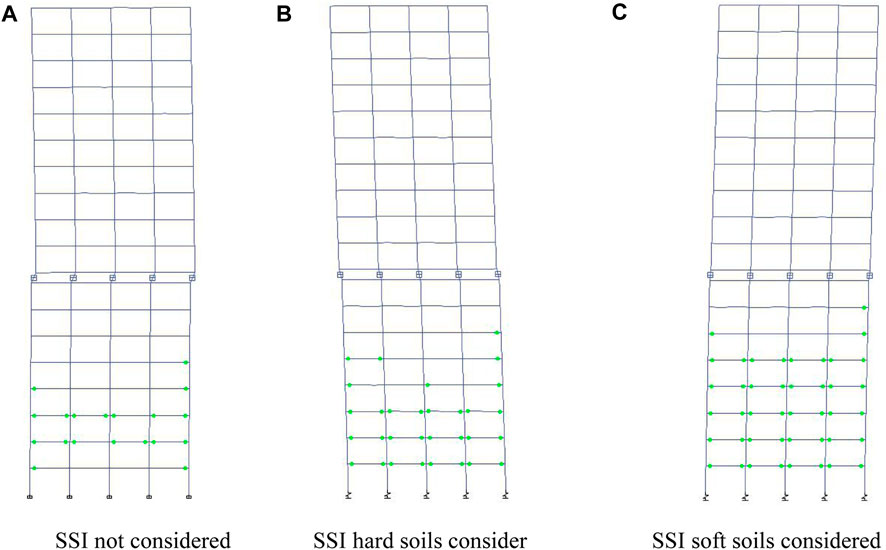
FIGURE 3. Structural plastic hinge. (A) SSI not considered. (B) SSI hard soils consider. (C) SSI soft soils considered.
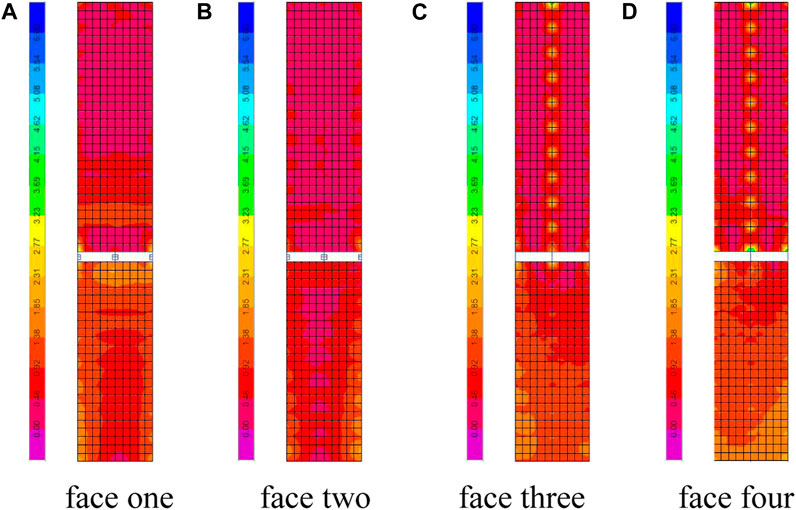
FIGURE 4. Structural damage not considering SSI effects. (A) face one. (B) face two. (C) face three. (D) face four.
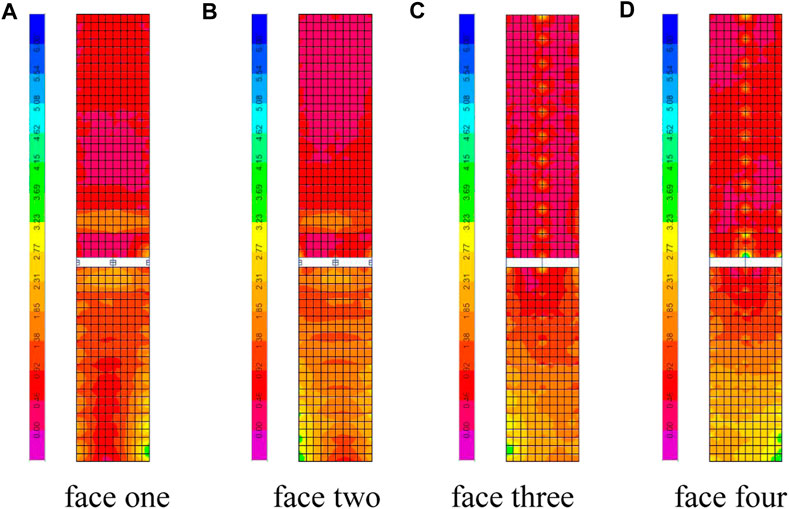
FIGURE 5. Structural damage of the hard soil considering SSI. (A) face one. (B) face two. (C) face three. (D) face four.
From Figures 3–6, it can be seen that under the action of earthquakes, the structural plastic hinge state of the mid-story isolated structure with an irregular plan considering SSI effect are all in the yielding stage (green dots in Figure 3), and the number and stress value of the structural plastic hinge are both greater than that without considering SSI effect.
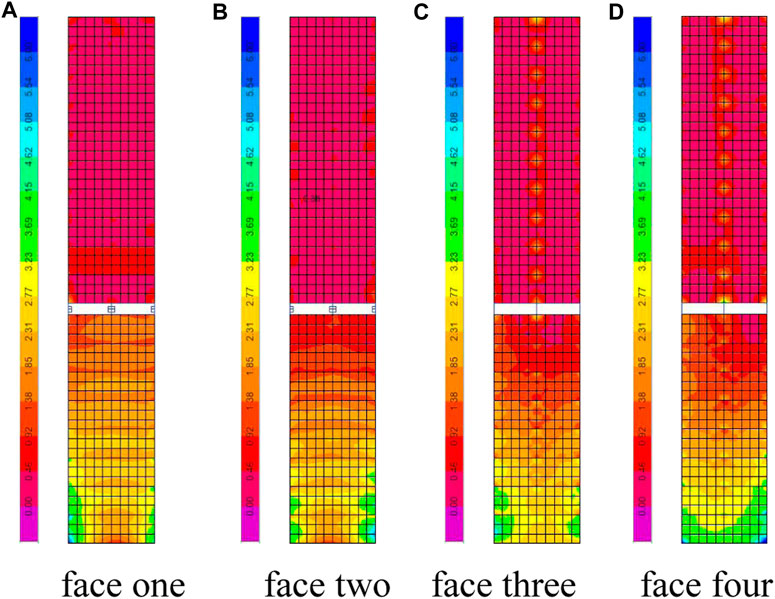
FIGURE 6. Structural damage of the soft soil considering SSI. (A) face one. (B) face two. (C) face three. (D) face four.
3 Analysis of the shock absorption effect
3.1 Modal period
As can be seen from Table 3, the period of the mid-story isolated structure with an irregular plan increases when the SSI effect is taken into account, and the increase of the period is slightly greater when the foundation is a soft soil than a hard soil. This is due to the interaction between the soil and the structure softening the stiffness of the structure. Therefore, the structure becomes more flexible and the period is extended.

TABLE 3. Modal period of the first 6 orders of the structure for different properties of the substrate.
3.2 Seismic damping performance
When different properties of soil are used in the substrate, HEL, IPM, and NWC waves are input as excitation of the mid-story isolated structure and the seismic response analysis is carried out to obtain the comparison of the inter story shear force and the base shear force of the structure as shown in Figures 7, 8.
As can be seen from Figure 7, the inter-storey shear force of the main body of the mid-story isolated structure with an irregular plan decreases layer by layer under the action of ground shaking. Considering the SSI effect, the inter-storey shear force of the mid-story isolated structure is significantly greater than that of the structure without considering SSI. Considering the SSI effect, the inter story shear force of the soft soil in the base is slightly larger than that of the hard soil in the substrate. This is because the stiffness of the structure is softened when considering the SSl effect, and the softer the soil is, the more obvious this effect is.
As can be seen from Figure 8, the shear force of the base of the mid-story isolated structure with an irregular plan considering the SSI effect under earthquake action is slightly larger than that without SSI effect. Although the change is relatively small, due attention should be paid to the structure design.
3.3 Torsional effects
The structure with an irregular plan are very prone to generate torsional effects under earthquake action, amplifying earthquake damage to the building. Seismic response analysis was carried out when the substrates with different properties are used for this structure, and the torsional displacement ratio (the maximum inter-storey displacement/average inter-storey displacement) was obtained as shown in Figure 9, and the torsional coefficients (torsional ratio column under modal analysis) are shown in Table 4.
From Figure 9 and Table 4, it can be seen that the torsional displacement ratio and torsional coefficient of the mid-story isolated structure with an irregular plan considering the SSI effect are greater than those without the SSI effect, and the soft soil substrate brings greater torsional displacement ratio and torsional coefficient to the structure than the hard soil substrate. This is due to the fact that the filling of the substrate reduces the stiffness of the bottom of the structure, which increases the torsional effect of the structure and makes it more susceptible to torsional damage and increases the adverse effects of earthquakes on the upper structure, therefore, the adverse effects of the lower soil layer on the torsion of the structure should be fully considered when designing the structure with an irregular plan.
4 Discussion and conclusion
4.1 Discussion
In this paper, the finite element analysis software ETABS is used to analyse the seismic response of the mid-story isolated structure with an irregular plan, and the seismic response analysis and damage of the structure are studied in terms of seismic wave selection, inter-layer shear force, structural damage, etc. It is concluded that the mid-story isolated structure with an irregular plan has good seismic isolation effect under ground shaking.
The research in this paper also allows for further research in the following areas.
(1) The model in this paper is a mid-story isolated structure with an irregular plan, which is limited by the calculation time and the calculation operation equipment, so the number of calculations for the typical ground shaking condition is small and not universal. Fabio and Alfonso (2009) studied the adverse effects of near-fault earthquakes on base-isolated frame structures using European norms, and drew the conclusion that preventive measures should be taken for near-fault earthquakes, especially for base-isolated structures located on soft soil. In the next step, we should screen the typical ground shaking in different regions of the world and compare them with each other, calculate a few more conditions and draw lessons from them.
(2) There is a lack of research and analysis on vertical ground vibration of super tall conjoined structures. Trishna and Hemant (2020) carried out a vulnerability analysis of vertically irregular buildings, which could effectively predict the actual damage of such buildings observed in past earthquakes. The next step is to compare the vertical vibration comfort evaluation standards of various countries and recommend a relatively practical comfort evaluation standard suitable for conjoined structures.
(3) The parameters of seismic isolation bearings, BRBs and viscous dampers in the damage control scheme for interval seismic structures with planar irregular layers are less studied in this paper. Raz and Gopal (2018) investigated the effectiveness of tuned mass dampers (TMD) in dynamic soil-structure interaction systems. In the future, more in-depth studies can be conducted on the influence of more dampers parameters on the damage control and seismic performance of the structure, and a universal design method for the selection of dampers parameters can be established, and the reasonable between the stiffness of the dampers and the stiffness of the connected body, and between the stiffness of the dampers and the stiffness of the strengthened layer The influence of the stiffness values on the response of the structure under strong earthquakes requires more research and discussion.
(4) In this paper, the seismic response analysis of the mid -story isolated structure with an irregular plan is mainly based on the horizontal earthquake, and does not consider the different foundation size. Dao and Ryan (2022) studied the seismic response of structures under 3D earthquakes, showing that the response of the computational model is very sensitive to the hysteresis damping ratio of soil, Poisson’s ratio of soil and the foundation size. Further studies are needed to investigate the isolation effect of the plane irregular layer spacer structure under the actual earthquake action including vertical earthquake action.
(5) The mid-story isolated system adopted in this paper is the traditional lead-core rubber isolated bearing system. Mohammad et al. (2022) studied the new multi-directional isolation (MDSI) system, which can effectively reduce the damage to the structure caused by earthquake compared with the basic isolated system. Further study is needed to determine whether the better isolation effect can be achieved by using different isolation systems and different foundation size.
4.2 Conclusion
In conclusion, a model of a mid-story isolated structure with an irregular plan has been developed and analyzed using non-linear time analysis under seismic action with SSI effect. The analysis of the seismic response of the mid-story isolated structure with an irregular plan when different properties of soil substrates are used has been compared, and the following conclusions can be drawn.
(1) The seismic response of the mid-story isolated structure with an irregular plan considering SSI effect increases under the action of earthquakes. The seismic response of soft soil considering SSI is greater than that of hard soil, and the softer the soil, the more obvious the effect. Therefore, attention should be paid to the design of high-rise building structure in a soft soil layer.
(2) Compared with the rigid foundation, the hard soil increased the first three periods of the structure period by 0.249 s, 0.330 s, and 0.054 s. The soft soil increased the first three periods of the structure period by 0.399 s, 0.455 s, and 0.139 s. After considering the SSI effect, the base shear increases by about 10%, and the structural plastic hinge and stress damage also increase. Therefore, designers should pay attention to these effects in the design.
(3) Under the action of earthquakes, the torsional displacement ratio and torsional coefficient of the mid-story isolated structure with an irregular plan considering SSI effect increase, which amplifies the torsional effect of the structure. The softer the soil, the more obvious the amplification. Therefore, designers should fully consider this effect when constructing the structure with an irregular plan in a soft soil layer to avoid unsafe designs in actual seismic resistance without considering SSI effect.
Data availability statement
The original contributions presented in the study are included in the article/supplementary material, further inquiries can be directed to the corresponding authors.
Author contributions
SX wrote the article as a whole and established the research content; CL drew the pictures and tables of the article; DL calculated the data of the article; WS gave important opinions on the research methods of the article; ML conducted an effective review of the article. All authors contributed to the article and approved the submitted version.
Conflict of interest
The authors declare that the research was conducted in the absence of any commercial or financial relationships that could be construed as a potential conflict of interest.
Publisher’s note
All claims expressed in this article are solely those of the authors and do not necessarily represent those of their affiliated organizations, or those of the publisher, the editors and the reviewers. Any product that may be evaluated in this article, or claim that may be made by its manufacturer, is not guaranteed or endorsed by the publisher.
References
Attanasi, G., and Auricchio, F. (2011). Innovative superelastic isolation device. J. Earthq. Eng. 15(1), 72–89.
Bujar, M., Mitsumasa, M., Masanori, I., and Masayoshi, I. (2002). Seismic behavior of a newly developed base isolation system for houses. J. Asian Archit. Build. Eng. 1 (2), 17–24. doi:10.3130/jaabe.1.2_17
Castaldo, P., and Tubaldi, E. (2018). Influence of ground motion characteristics on the optimal single concave sliding bearing properties for base-isolated structures. Soil Dyn. Earthq. Eng. 104, 346–364. doi:10.1016/j.soildyn.2017.09.025
Chang, Z., Du, Z., Zhang, F., Huang, F.*, Chen, J., Li, W., et al. (2020). Landslide susceptibility prediction based on remote sensing images and GIS: Comparisons of supervised and unsupervised machine learning models. Remote Sens. 12, 502. doi:10.3390/rs12030502
Christos, G., and Dimitrios, K.Associate Professor Constantinos Repapis (2020). Seismic isolation: An effective technique for the seismic retrofitting of a reinforced concrete building. Struct. Eng. Int. 30 (1), 43–52. doi:10.1080/10168664.2019.1678449
Dao, N. D., and Ryan, K. L. (2022). Soil–structure interaction and vertical-horizontal coupling effects in buildings isolated by friction bearings. J. Earthq. Eng. 26 (4), 2124–2147. doi:10.1080/13632469.2020.1754969
Devis, S., Andrea, P., and Marco, C. (2020). Seismic retrofit of an industrial building using damping devices. Struct. Eng. Int. 30 (1), 53–63. doi:10.1080/10168664.2019.1635975
Diana, F., Bruno, C., and Elena, M. (2022). Seismic retrofit of existing masonry buildings through inter-story isolation system: A case study and general design criteria. J. Earthq. Eng. 26 (4), 2051–2087. doi:10.1080/13632469.2020.1752854
Didier Pettinga, J., Nigel Priestley, M. J., Pampanin, S., and Christopoulos, C. (2007). The role of inelastic torsion in the determination of residual deformations. J. Earthq. Eng. 11(1), 133–157.
Fabio, M., and Alfonso, V. (2009). Nonlinear response of RC framed buildings with isolation and supplemental damping at the base subjected to near-fault earthquakes. J. Earthq. Eng. 13 (5), 690–715. doi:10.1080/13632460802632302
Faming, H., Zhongshan, C., Shui-hua, J., Chuangbing, Z., Zizeng, G., and Guo, Z. (2020). Landslide susceptibility prediction based on a semi-supervised multiple-layer perceptron model. J. Landslides 17, 2919–2930. doi:10.1007/s10346-020-01473-9
Ferj, M., and Lopez-Garcia, D. (2022). Comparative seismic fragility analysis of conventional and base isolated hospital buildings having different structural systems. J. Earthq. Eng. 26 (5), 2491–2513. doi:10.1080/13632469.2020.1767229
Giovanni, C., Antonio De, L., and Elena, M. (2008). Design aspects in seismic isolation: Application to retrofit churches. Int. J. Archit. Herit. 2 (3), 247–273. doi:10.1080/15583050802063741
Hitesh, K., and Sandip Kumar, S. (2022). Effects of soil-structure interaction on seismic response of fixed base and base isolated liquid storage tanks. J. Earthq. Eng. 26 (12), 6148–6171. doi:10.1080/13632469.2021.1911887
Huang, F., Jing, Z., Chuangbing, Z., Yuhao, W., Jinsong, H., and Li, Z. (2020). A deep learning algorithm using a fully connected sparse autoencoder neural network for landslide susceptibility prediction. Landslides 17 (01), 217–229. doi:10.1007/s10346-019-01274-9
Jaya, V., Dodagoudar, G., and Boominathan, A. (2008). Seismic soil-structure interaction analysis of tall slender structures. Int. J. Geotechnical Eng. 2 (4), 381–393. doi:10.3328/ijge.2008.02.04.381-393
Jean, C. G. P., and Keri, L. R. (2020). Slab vibration and horizontal–vertical coupling in the seismic response of low-rise irregular base-isolated and conventional buildings. J. Earthq. Eng. 24 (1), 1–36. doi:10.1080/13632469.2017.1387197
Jianbing, C., Weiqing, L., Yongbo, P., and Jie, L. (2007). Stochastic seismic response and reliability analysis of base-isolated structures. J. Earthq. Eng. 11 (6), 903–924. doi:10.1080/13632460701242757
Jiang, S. H., Huang, J., Huang, F., Yang, J., Yao, C., and Zhou, C. (2018). Modelling of spatial variability of soil undrained shear strength by conditional random fields for slope reliability analysis [J]. Appl. Math. Model. 63, 374–389.
Johanes, C., and Philippe, G. (2019). Nonlinear response of soil–structure systems using dynamic centrifuge experiments. J. Earthq. Eng. 23 (10), 1719–1741. doi:10.1080/13632469.2017.1398692
Kosmopoulos, A. J., and Fardis, M. N. (2008). Simple models for inelastic seismic analysis of asymmetric multistory RC buildings. J. Earthq. Eng. 12 (5), 704–727. doi:10.1080/13632460701673126
Kosmopoulos, J., and Fardis, M. N. (2008) Simple models for inelastic seismic analysis of asymmetric multistory RC buildings,J. Earthq. Eng. 12(5), 704–727. doi:10.1080/13632460701673126
Kyoung, M. R., Min, S. K., and Young, H. L. (2021). A simplified approach to modeling vertically irregular structures for dynamic assessment. J. Asian Archit. Build. Eng. 21, 2320–2329. doi:10.1080/13467581.2021.1971682
Li, X. L., Chen, S. J., Liu, S. M., and Li, Z. H. (2021a). AE waveform characteristics of rock mass under uniaxial loading based on Hilbert-Huang transform. J. Central South Univ. 28 (6), 1843–1856. doi:10.1007/s11771-021-4734-6
Li, X. L., Chen, S. J., Wang, S., Zhao, M., and Liu, H. (2021b). Study on in situ stress distribution law of the deep mine taking Linyi Mining area as an example. Adv. Mater. Sci. Eng. 9 (4), 5594181–5594211. doi:10.1155/2021/5594181
Li, X. L., Zhang, X. Y., Shen, W. L., Zeng, Q., Chen, P., Qin, Q., et al. (2023). Research on the mechanism and control technology of coal wall sloughing in the ultra-large mining height working face. Int. J. Environ. Res. Public Health 20 (2), 868. doi:10.3390/ijerph20010868
Liu, H. Y., Zhang, B. Y., Li, X. L., Liu, C., Wang, C., Wang, F., et al. (2022). Research on roof damage mechanism and control technology of gob-side entry retaining under close distance gob. Eng. Fail. Anal. 138 (5), 106331. doi:10.1016/j.engfailanal.2022.106331
Liu, S. M., Li, X. L., Wang, D. K., et al. (2020). Investigations on the mechanism of the microstructural evolution of different coal ranks under liquid nitrogen cold soaking, Energy Sources, Part A: Recovery, Utilization, and Environmental Effects, 1–17.
Losanno, D., Ravichandran, N., Parisi, F., Calabrese, A., and Serino, G. (2021). Seismic performance of a Low-Cost base isolation system for unreinforced brick Masonry buildings in developing countries. Soil Dyn. Earthq. Eng. 141, 106501. doi:10.1016/j.soildyn.2020.106501
Luis E Pérez, -R., Javier, A-L., and Arturo, T-C. (2021). Base isolation for mid-rise buildings in presence of soil-structure interaction. Soil Dyn. Earthq. Eng. 151, 2021.
Micozzi, F., Flora, A., Viggiani, L. R. S., Cardone, D., Ragni, L., and Dall’Asta, A. (2021). Risk assessment of reinforced concrete buildings with rubber isolation systems designed by the Italian seismic code. J. Earthq. Eng. 26, 7245–7275. doi:10.1080/13632469.2021.1961937
Mohammad, M. P., James, B. P. L., Iman, H., and Daniel, M. (2022). Multi-directional base isolation system for coupled horizontal and vertical seismic excitations. J. Earthq. Eng. 26 (3), 1145–1170. doi:10.1080/13632469.2020.1713925
Mohammed, H., Miloud, H., and Djamel, N. (2021). Vulnerability of asymmetric multi-storey buildings in the context of performance-based seismic design. Eur. J. Environ. Civ. Eng. 25 (5), 813–834. doi:10.1080/19648189.2018.1548380
Muberra, E. A., and Ibrahim, E. (2013). Soil–structure interaction effects on seismic behaviour of multistorey structures. Eur. J. Environ. Civ. Eng. 17 (8), 635–653. doi:10.1080/19648189.2013.810177
Peter, F., Damjan, M., and Iztok, P. (2005). Torsional effects in the pushover-based seismic analysis of buildings. J. Earthq. Eng. 9 (6), 831–854. doi:10.1080/13632460509350568
Raz, N. J., and Gopal, S. P. M. (2018). Tuned mass damper positioning effects on the seismic response of a soil-MDOF-structure system. J. Earthq. Eng. 22 (2), 281–302. doi:10.1080/13632469.2016.1224743
Repapis, C. C., and Zeris, C. A. (2020). Performance investigation of existing RC buildings with height irregularity using the IDA procedure. J. Earthq. Eng. 24 (12), 1944–1974. doi:10.1080/13632469.2018.1488777
Ryan, Keri L., and Earl, Curtis L. (2010). Analysis and design of inter-story isolation systems with nonlinear devices. J. Earthq. Eng. 14 (7), 1044–1062. doi:10.1080/13632461003668020
Sahar, M. O., Hamzeh, S., and Ghyslaine, M. (2022). Optimal performance-based configurations of stiffness and strength centers in multi-story wall-frame asymmetric buildings including soil–structure interaction effects. J. Earthq. Eng. 26 (11), 5978–6014. doi:10.1080/13632469.2021.1911881
Sekhar, C. D., Pranab, K. D., and Piyali, S. (2017). Seismic behaviour of irregular structures. Struct. Eng. Int. 27 (4), 526–545. doi:10.2749/222137917x14881938989765
Shi-Shuenn, C., Jun-Yang, S., and Yi-Ying, W. (2019). Numerical damage localisation for building systems including dynamic soil-structure interaction. Struct. Infrastructure Eng. 15 (3), 362–375. doi:10.1080/15732479.2018.1552711
Soheil, R., and Mansour, Z. (2017). A value-based design approach for base-isolated structural systems. Civ. Eng. Environ. Syst. 34 (1), 34–52. doi:10.1080/10286608.2017.1297802
Taskin, A., and Khan, M. A. (2020). Seismic response of randomly infilled reinforced concrete frames with soft ground storey. Aust. J. Civ. Eng. 18 (2), 153–163. doi:10.1080/14488353.2020.1745617
Trishna, C., and Hemant, B. K. (2020). Component level fragility estimation for vertically irregular reinforced concrete frames. J. Earthq. Eng. 24 (6), 947–971. doi:10.1080/13632469.2018.1453413
Vasiliki, G. T. (2022). Statistical analyses on the degree of influence of various assumptions in soil-structure interaction studies. Eng. Struct. 252, 113750. doi:10.1016/j.engstruct.2021.113750
Yazdan, H., GholamReza, H., Abolfazl, E., and Matteo, F. (2021). 3D soil-structure interaction analysis with a combined substructure-FEM under external forces and seismic waves, Mechanics of Advanced Materials and Structures.
Yongbo, P., Tianchen, H., and Jianbing, C. (2022). Experimental study of seismic isolated structures with sliding implant-magnetic bearings. J. Earthq. Eng. 26 (5), 2514–2545. doi:10.1080/13632469.2020.1767230
Zeshan, A., Li, S., Chunwei, Z., Zhongxin, S., and Bijan, S. (2021). Experimental and numerical investigation on the complex behaviour of the localised seismic response in a multi-storey plan-asymmetric structure. Struct. Infrastructure Eng. 17 (1), 86–102. doi:10.1080/15732479.2020.1730914
Keywords: SSI effect, castor earthquake zone, planar irregularity, mid story isolation structure, seismic wave
Citation: Xiao S, Li C, Liu D, Sun W and Lei M (2023) Research on irregular plane mid story isolation structures in castor earthquake prone areas considering SSI effect. Front. Earth Sci. 11:1207110. doi: 10.3389/feart.2023.1207110
Received: 17 April 2023; Accepted: 05 June 2023;
Published: 28 July 2023.
Edited by:
Xuelong Li, Shandong University of Science and Technology, ChinaReviewed by:
Anquan Xu, Tianjin University, ChinaChaoyu Chang, Institute of Disaster Prevention, China
Copyright © 2023 Xiao, Li, Liu, Sun and Lei. This is an open-access article distributed under the terms of the Creative Commons Attribution License (CC BY). The use, distribution or reproduction in other forums is permitted, provided the original author(s) and the copyright owner(s) are credited and that the original publication in this journal is cited, in accordance with accepted academic practice. No use, distribution or reproduction is permitted which does not comply with these terms.
*Correspondence: Cheng Li, bGljaGVuZ0BoZWJuZXR1LmVkdS5jbg==; Dewen Liu, Y2l2bGlfbGl1ZGV3ZW5Ac2luYS5jb20=; Weiwei Sun, MzI1OTE0NTA4NkBxcS5jb20=
 Shuai Xiao
Shuai Xiao Cheng Li
Cheng Li Dewen Liu1*
Dewen Liu1*